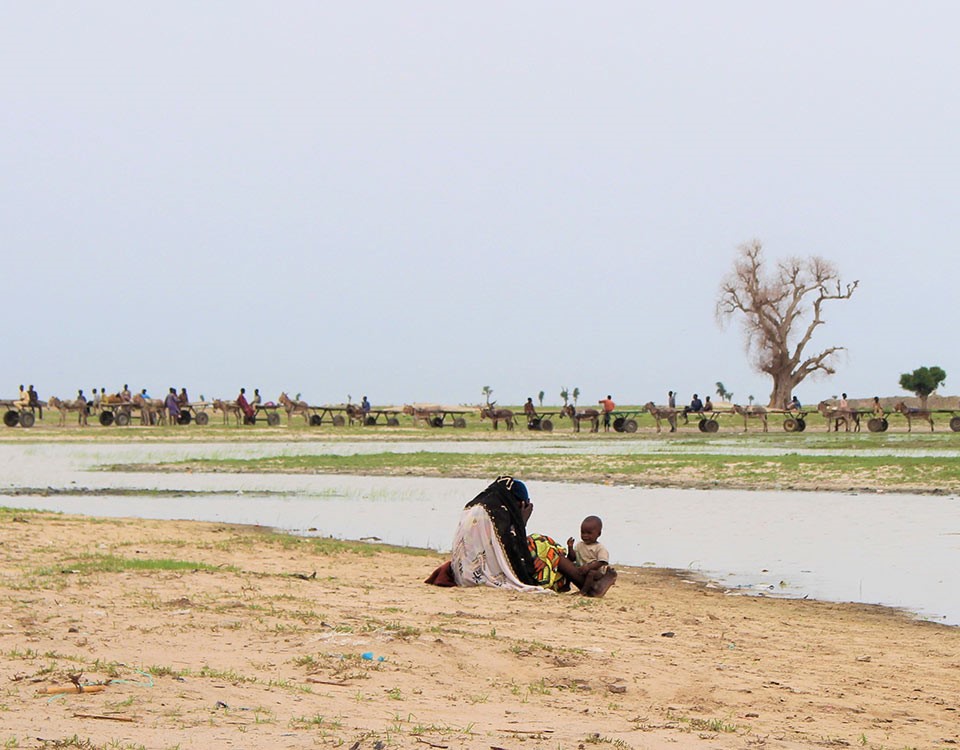
Chad: A landlocked country in the heart of the African continent, in the center of the Sahara, as large as France, Italy and Germany combined (1,284,000 km²), but almost uninhabited: until 20 years ago, the population of Switzerland. Today they’ve doubled and count nearly 16 million of souls, but there’s still plenty, plenty of free space.
Those who believe that there are only dunes and wind are completely mistaken: in the country it goes from the height of 3415 meters of the extinct volcano Emi Koussi, white lava rock in a lunar landscape, scattered between the mountains from Tibesti, to the northern plateau of the Ennedi, which slowly descends below sea level – first the sand, then the funnels of all the major rivers of Central Africa and finally, almost to the border with Cameroon and Nigeria, towards the large lake which gives its name to the nation: Chad, once one of the ten largest lakes in the world, is today due to global warming and the use of water to irrigate fields, “only” four times larger than Lake of Geneva, Lake Balaton or Lake of Constance[1]. A lake in agony because it is gripped by the influence of climate change which is drying it up; Added to this is the growing crush on the persecution and the increase in illegal immigrants, as well as the indiscriminate violence of the Muslim sect of Boko Haram.
The lake is fed by long, lazy rivers and has no drains. The largest of them, the Chari and the Logone, come from the mountains from over 1000 km, where it rains a lot and it’s cold, and they carry a lot of water. As one of the deepest points on the planet and of volcanic origin, it is a dead-end trough and a world of its own with rules unlike any other lake. As it generously exceeds 45°, like in summer in N’Djamena, to the north, there is a forest around Lake Chad and behind a huge savannah – and cool[2]. But Chad is a shallow lake, no more than ten meters deep, and calm. Always. For this reason, more and more people will be living on its shores – they are doubling every twenty years, they are already above 50 million, and there are fears that the threshold of 80 million will be exceeded by 2030[3].
People come because the lake is famous for being very rich in fish; around the basin, the land is fertile. Agriculture and livestock allowed the prehistoric nomads to settle. About 8,000 years ago, one of our ancestors built a canoe on the shores of Lake Chad which has come down to us intact and is perhaps the oldest one ever discovered by archaeologists[4]. Thus, in Lake Chad, fishing became the main industry in an endless area stretching from the Sahara to the equatorial jungle – an area which has been populated for millennia by tribes originally separated by enormous distances. and by a lush natural environment which sometimes tends to exacerbate human artifacts.
Barely 90 years ago, thanks to the arrival of the Igbo, the most advanced and populous ethnic group among the people living in Nigeria, fishing in Lake Chad, they reached a turning point: the Igbo[5] know the technique of smoking fish (they call it “Banda“), and make it so portable and durable[6] that they can sell the fish in large markets from remote locations to the shores of the ocean. In the 1950s, an ethnic group from northern Chad, the Hausas[7], introduced the use of nylon thread for the manufacture of nets, then the first motorized canoes[8]. It is the beginning of an intensive exploitation of the lake and therefore the beginning of the end for the biological balance of Lake Chad.
In addition to the local communities that have settled around the lake since prehistoric times, the multi-ethnic nature of the region is a typical feature: today Lake Chad attracts more than ever migrants from Cameroon (Musgum, Kotoko, Zina and Mora[9]): tribes who live off fishing and have experienced violent tribal conflicts in the past[10]. Then, in the 1970s, refugees from Mali, Senegal and Niger also came and – when the water flowed – they settled in the countryside and began to cultivate it. The wave of new residents came to an end in 2007 when the area became the beating heart of bloody terror spread by the Islamic sect Boko Haram[11]. Despite persecution, drought and global warming, the Darak market on the northern border of Cameroon still sells more than 200 tons of fish per year[12].
The sad pain of the great dying lake
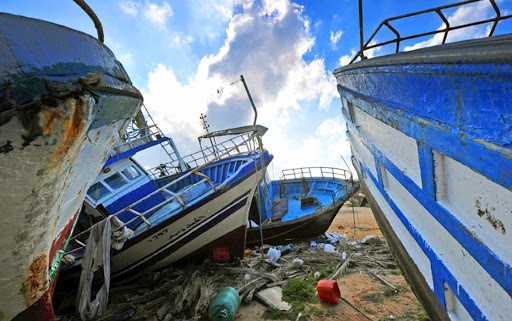
Abandoned boats in the shallows of Lake Chad: what remains of decades of industrial fishing after the lake shrinks to a tenth of what it was 50 years ago[13]
Especially since the lake has been an oasis of peace for centuries. The different ethnic groups who gathered on the shores and islands had developed a common language, Kanuri, whose word Chade (phonetically: Sádǝ) literally means “great body of water“[14]. At the beginning of the 20th century, the lake was a corner of paradise: many small towns extending over dozens of islands rich in vegetation, with waters rich in fish; There are vegetable gardens and farms everywhere blooming in the villages that rise up on the banks[15]: according to Moussa Mainakinay, a local inhabitant interviewed in a brochure by Ben Taub, it was not until the 1970s that locals realized that the sea began to die: “Floating masses of reeds and water lilies began to obstruct the remaining streams, making it impossible to navigate the ancient trade routes between the islands“[16].
The difficulty of moving through the labyrinth of vegetation and swamps, which contributed to the transboundary character of the lake, made the lake an area of uncontrollable chaos – and therefore one of the main routes of contraband: the illegal trade in immigrants (sometimes slaves) who fled the wars in Libya or Sudan[17] or the misery of West African countries; drug trafficking, mainly from India, used by Boko Haram throughout Central Africa[18] as a basis for negotiations for the purchase of arms, ammunition, medicine, food and fuel[19]. Everything becomes difficult and dangerous: every village is constantly forced to make round trips from the wetland to a dry area throughout the year and to go hiking, depending on the daily conditions of the lake – a challenge for the administration, because these villages are independent of their current position, but still have the same toponym[20].
Faced with such a magmatic image at the morphological, hydrographic, climatic, geopolitical and anthropological levels, the balance between the inhabitants of the lake is extremely unstable. Regardless of the nefarious influence of Muslim terrorism, various tribes live around the lake who are forced to move constantly in order to survive and are therefore forced to share and compete for land and water supplies, creating enormous tensions and sudden violent conflict[21].
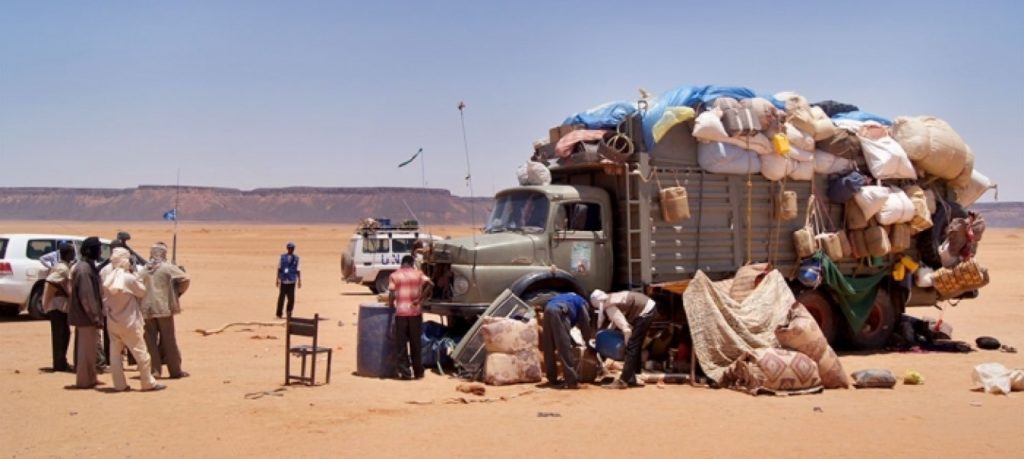
Every day, the Chadian police try to filter the thousands of illegal immigrants and separate those fleeing the war from the smugglers who trade in Boko Haram[22]
Chad has traditionally been marked by a series of ethnically and religiously motivated civil wars (there is bitter hostility between the Muslim north and the animist and partially Christianized south[23]). The State of Chad is unable to cope with the emergency and the only plans that have worked effectively over the past decade have been developed by Cameroon, which investing in money and men (army, doctors and teachers) to face the crisis: the interference of Boko Haram has dealt the last blow to an already deeply wounded region: the ongoing attacks by the terrorist group, which is increasingly invading the maritime population, show that this sect hopes unite in the jungle on the border between Nigeria, Cameroon and Chad Creation of the Islamic State – which creates an unbearable humanitarian emergency[24].
The Yaoundé government has launched two programs. The first concerns the town of Darak, which emerged as a sort of slum on the islands that emerged from the lake in the summer and now that the water has receded it has become a large fish and arms market, entirely control of Boko Haram, where the sect has blackmailed the percentages in case the dealers want to continue working[25]. The situation improved after a massive attack by militias of the Muslim sect was repelled by the Cameroonian army on June 9 and 10, 2019: 16 soldiers from Yaoundé died, but also more than 90 militiamen from Boko Haram[26].
Since then, the Cameroonian government has learned its lesson and launched an ambitious and costly plan to transform a slum into a veritable provincial capital with judicial, military and administrative buildings in just five years[27]. In 2013, Darak was awarded the equivalent of $ 11.15 million to pave the road between Darak port and the country’s northern province, complete missing buildings, restore dilapidated buildings, operate a school and set up a school. In addition, there is a permanent clinic, the establishment of a football team (as an identification project with the territory) and the repair of new opportunities for the marketing of fish, sheep farming and agricultural products on the main markets of Yaoundé[28].
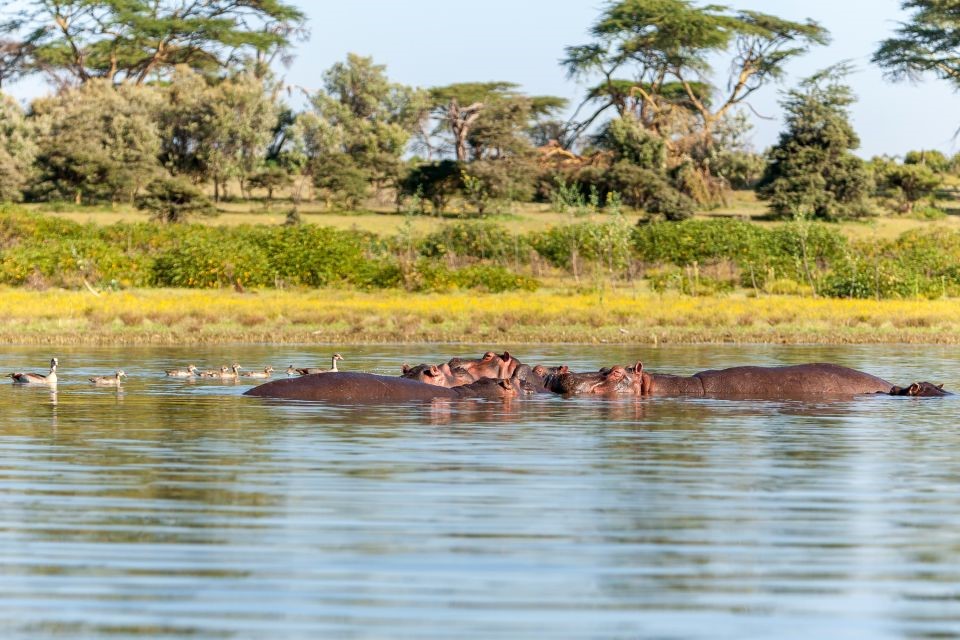
Among the intergovernmental projects, one of the most important is that of the WWF to protect the flora and fauna of Lake Chad[29]
At the district level, however, the series of decisions taken is more complex: first, the government pragmatically decides not to adopt the South African model. The Pretoria model is based on equality between four equal powers (legislative power of parliament, executive power of government, judicial power of judicial authority, veto power of tribal assemblies[30]); Cameroonian law prefers to give the judiciary the power to make decisions on tribal issues if the government fails to find an amicable compromise in the disputes[31].
The guidelines of the central government program, however, provide for a whole series of special measures for the area around Lake Chad: a) Recognition of religious communities and equality of schools of different faiths; b) administrative and legal recognition of nomadism; c) investment funds for sedentary economic activities; d) increase in military and administrative personnel, preferential recruitment of local personnel; e) framework laws for the application of the economic and social measures of the central government harmonized with the six main tribes recognized as owners of the territory; f) Promotion of local radios, cultural and sports centers which emphasize identification with the territory as a value superior to tribal and religious differences, which is justified in the confirmation of the dichotomy: Cameroonian = good, Boko Haram = bad – a position shared by the whole population[32].
To this is added not only a permanent military campaign, but also a series of technological and cyber defense measures against the Muslim sect, which aim to establish a second dichotomy: Cameroonian = modern, Boko Haram = medieval[33]. This ambitious project, which is already bearing fruit, is linked to the decisive effect: Defending the identity of the Lake Chad community and increasing well-being and social solidarity as well as resentment against Boko Haram also promote coexistence between different ethnic groups – the hope is that within a few generations tribal differences can be eliminated through the common struggle for the survival of the Lake Chad ecosystem and intermarriages[34].
The fight against the Boko Haram sect
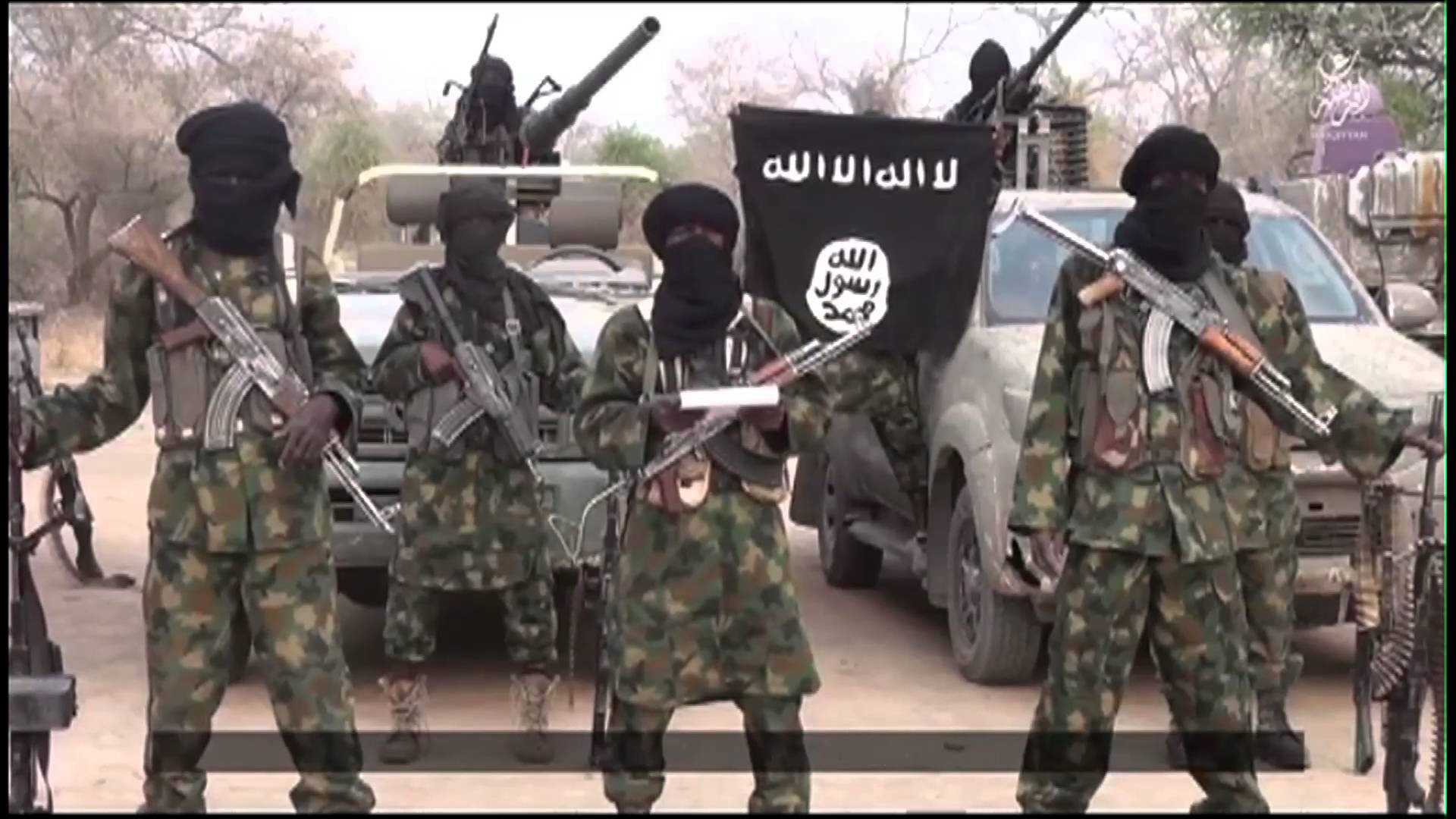
Boko Haram militiamen pose to promote their own terrorist strategy[35]
In 2002, preacher Mohammed Yusuf, who belongs to the Izala movement, founded an Islamic Salafist group based in Maiduguri (the northeastern capital of Nigeria’s Borno state): a new movement called Boko Haram, a term in the Hausa language[36]. whose translation is “Westernization is a sacrilege“[37]. First the movement gains space and followers because it (supposedly) fights corruption and proposes itself as a citizens’ group to support religious education – but as soon as the militia has reached a certain number soldiers and money from al-Qaeda’s channels flowing, things themselves have changed dramatically[38]: in a short time, the religious and terrorist group has made a reputation for indiscriminate violence and sectarian fanaticism : in 2009, there were already more than 3,400 armed attacks that claimed more than 36,000 victims and the flight (or deportation) of 2.3 million Nigerians to flee at least 250,000 of them to Cameroon or the Chad in the Great Lakes region[39].
Over the years, the initial goal of building a state of Islamic fundamentalists on Nigerian territory has become a simple struggle for survival: in 2014 alone, the victims of anger against Boko Haram reached the number of 6,600 people[40]. Despite a drop in the number of terrorist activities due to military defeats[41], the jihadist organization has survived in recent years in the Sambisa forest, a few kilometers from Lake Chad. Boko Haram is barricaded, the unemployed and refugees[42] are still being recruited and currently (according to the “Global Terrorism Index” of 2018[43]) is the fourth blood-thirstiest group in the world and “boasts” of first place in sub-Saharan Africa.
For the past five years, the militia’s actions have been a rampage and have nothing to do with any military strategy. In February 2015, during the night, a group of ten terrorists crossed Lake Chad in motorboats: they reached a fishing village, Ngouboua, and committed a massacre, burned houses, attacked the post of police and killed the village chief in cold blood[44]. The reason for the attack, which will be followed by several more[45], is that Ngouboua is hosting thousands of Nigerian refugees who have fled persecution from Boko Haram[46].
The series of attacks convinced at least the Chadian government to face the threat militarily in order to support the actions of the Nigerian army: in the spring of 2015, the Chadian armed forces took back Gamboru Ngala, a Nigerian town besieged by Boko Haram. During months. Boko Haram has unleashed itself against civilian targets in Chad[47]. According to a decision by the European Union[48], which financially supports the joint war efforts of Nigeria and Chad, only Niger is still completely disarmed in the face of the threat posed by the savage Muslim sect[49]. Since then, many militiamen displaced from Boko Haram have settled in the islands of the lake and have continued to spread terror[50].
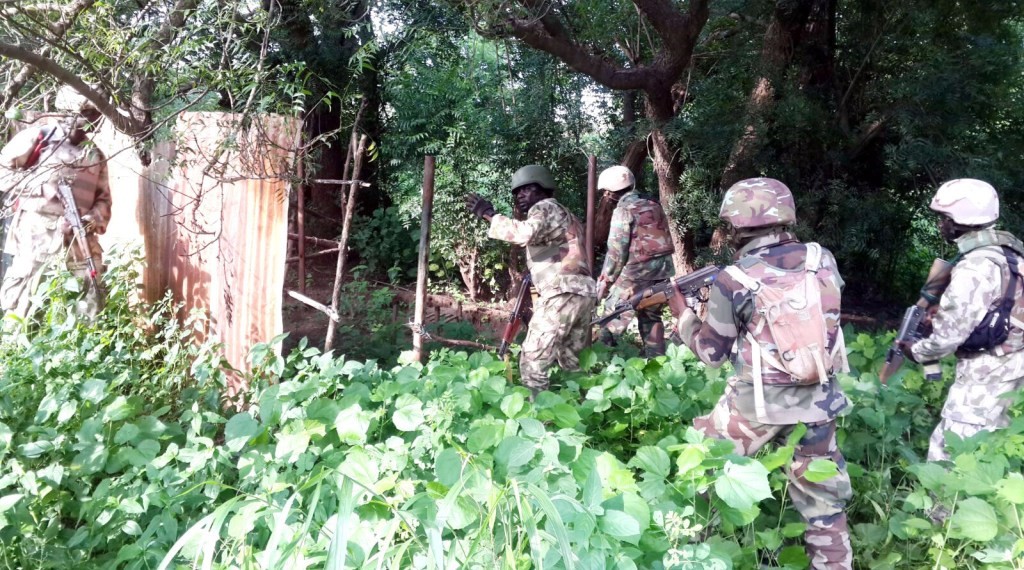
Nigerian army units pursuing barricaded Boko Haram militiamen in the Sambisa forest – a few kilometers from Lake Chad[51]
After the military defeat in Nigeria, the leaders of Boko Haram change their strategy and moved to fight for the birth of ISWAP (Islamic State’s West African Province[52]), at the beginning, necessarily without resorting to force, but with propaganda activity. They took advantage of the shortcomings of the administration of the State of Chad and the growing discontent of the inhabitants[53]. From the fall of 2015, ISWAP will start providing basic services, organizing work and other activities, replacing the central government where it can. The new militia sets out to strengthen itself and enjoy popular sympathy – as soon as ISWAP’s penetration is accompanied by visible economic support[54].
Currently, ISWAP controls the pattern of trade in the Niger area on Lake Chad and controls (militarily) activities related to the fish trade: from the initial production of dried fish to sale to brokers in major national markets; for the transport and storage of fish and its transport to the outskirts of Diffa, Bosso – then to the markets of Geidam and Hadeija in Nigeria and Kinchandi in Niger. ISWAP directly manages each phase of the process or gets paid to ensure it continues safely[55]. Apparently, retail and logistics prices are imposed with systematic coercion, while pressure and violence are used against disgruntled fishermen and traders[56].
To counter this new threat, the countries bordering Lake Chad have formed a military alliance called MNJTF (Multinational Joint Task Force), originally founded by the Chadian government agency LCBC (Lake Chad Basin Commission). In the summer of 2012, the FMM was made up of 700 soldiers from Chad, 700 Nigerians and 700 Cameroonians and a single joint command[57]. This militia was partially funded by an economic support program from the European Union, which was unanimously adopted by the European Council on February 9, 2015 and funded by the Fund for Peace in Africa (APF)[58].
From then on, the APF financed the salaries, provisions and medicines of the troops, but also the supply of equipment for the command, control, communication and information systems[59]. The MNJTF significantly ended terrorist violence, freed civilian hostages, opened avenues for humanitarian intervention, but failed in its goal of integrating troops from different nations due to issues of “inconsistent engagement of the nation, violence, funding issues and disjointed planning”[60].
The most complex humanitarian crisis of our time
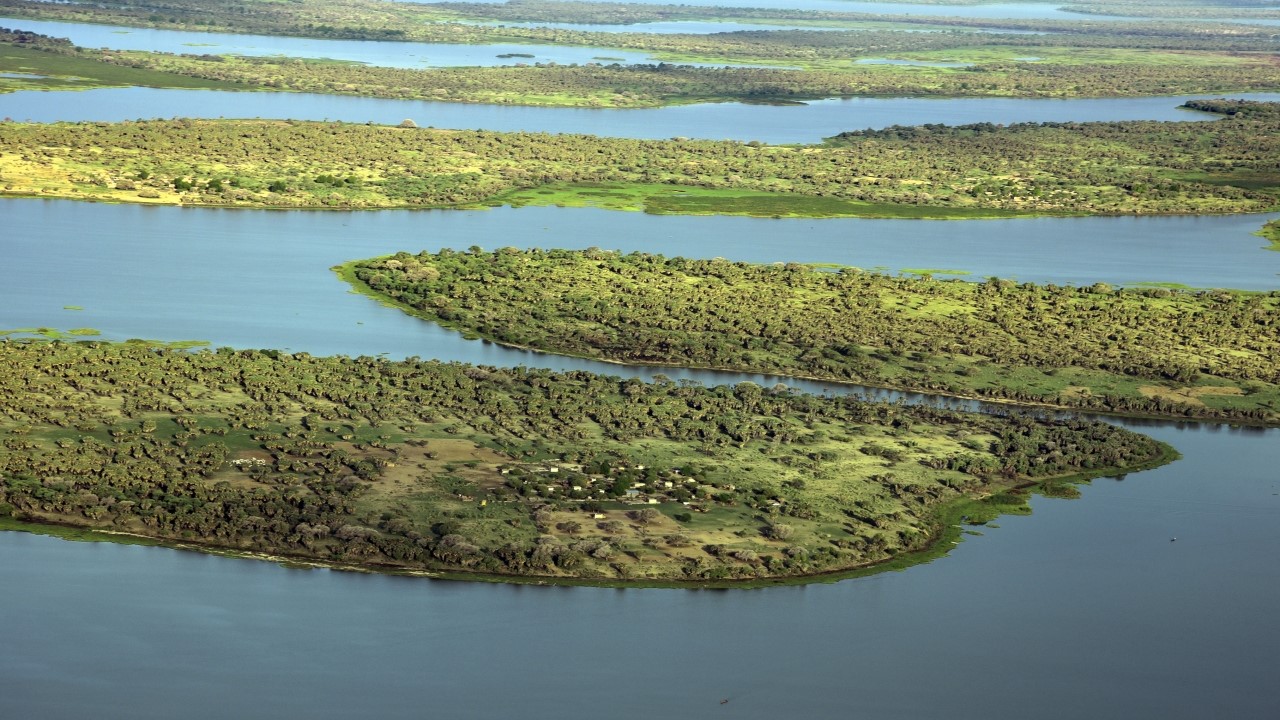
In the dingy and damp houses on the shores of Lake Chad, the fishermen await the rainy season and the return of the big fishermen[61]
In addition to internal migration and tensions along the borders between Chad, Niger, Nigeria and Cameroon, the Lake Chad region has been the scene of clashes since 1965[62] when the civil war and genocide in Biafra[63], raids in Central African Republic and famine in Sudan brought 450,000 refugees to the lake[64]. Today, more than 30 different ethnic groups live on the shores of Lake Chad: as the New Yorker writes, it is “the most complex humanitarian crisis of our time“[65]. Among the countries of the Lakes region, Chad is undoubtedly the hardest hit: 80% of the population lives below the poverty line, only 9% have access to adequate health services, illiteracy is higher at 50% and infant mortality is among the highest on the planet[66].
The international community is not simply watching but intervenes. The United Nations’ Food and Agriculture Agency (FAO) opened a permanent office in N’Djamena in 1977. In 2004, an operations division was added to the representative office to coordinate research, research and development. analysis, technical support and financing of projects developed jointly with the national government[67]. There is therefore aid reaching the area as part of a generous program and under the careful control of an institution present in the region which has made it possible to prevent the humanitarian emergency from becoming a tragedy for 40 years[68]. Over the years, the projects have become more and more effective, as evidenced by the irrigation and crop restructuring measures in the Gorè region, which include military defense, school education and medical surveillance[69].
On September 25, 2007, the United Nations approved a Joint Intervention Mission in the Central African Republic and Chad (MINURCAT) to help defend civilians, promote the protection of human rights, the rule of law, human rights of man, and finally peace according to the directives already developed by the Cameroonian government. The mission ends its mandate on December 31, 2010, but when most of the peacekeepers have left, the core defense personnel stationed in the Central African Republic (BINUCA) remain and still work there[70].
Measures are also being taken to support the national debt: in 2015, the IMF and the World Bank decided to reduce Chad’s debt by $ 1.1 billion, fueled by the government’s good performance in terms of satisfactory macroeconomic stability[71]. In September 2018, the World Bank approved the PARCA Refugee Support Project: it is worth around $ 80 million to improve access to basic services and economic opportunities for around half a million hosts, refugees, internally displaced persons and ethnic communities[72].
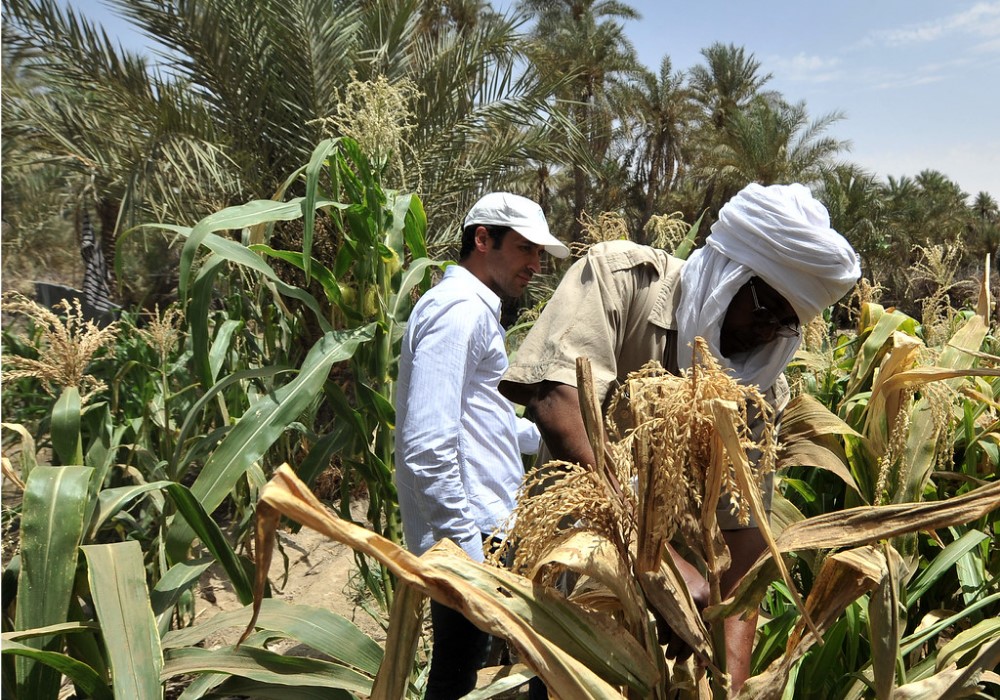
United Nations soldiers accompany FAO agronomists who, with an available fund of 81.9 million euros, are bringing intensive horticulture into the daily life of nearly 15 million people in Chad[73]
In April 2020, the International Monetary Fund, motivated by the crisis due to Covid-19, as part of the CCRT project (Catastrophe Containment and Relief Trust)[74], adopted a new resolution aimed at reducing the debts of the 25 poorest countries and therefore on the most vulnerable on the planet, including Chad[75]. In addition to this salvation measure, there will be an allocation of 22.6 million euros from the European Union through the Emergency Trust Fund for Africa in November 2020 to promote stability and security in the region of Sahel and Lake Chad through five projects – in total, thanks to the EU, since 2015, 5 billion euros have been made available to address the serious crisis in the region[76].
At the same time, FAO is working on several important projects related to the modernization of agriculture and the adaptation of production to changing climatic conditions. The RADHORT plan, initially drawn up by the Belgian government in 1988, is now applicable throughout Chad (and not just near the lake) to provide residents with mechanical means to irrigate fields, plant family gardens or for commercial production (free distribution of seeds and teaching of breeding techniques to farmers), defense against locusts and other harmful events, and establishment of contacts with regional distribution markets to sell part of the production[77].
However, in the northern part of Cameroon, FAO is focusing on tubers and roots and has carried out a rehabilitation project, preparing farmers, connecting to markets, distributing seeds and ensuring military defense: actions that have seen visible results brought to the entire malnourished area over the past three years[78]. For specific projects, there are programs at the continental level against the expansion of the desert[79] and for the reorganization of irrigation (AICCA project), which have become necessary due to global warming[80].
Thirty years of torrid political freeze
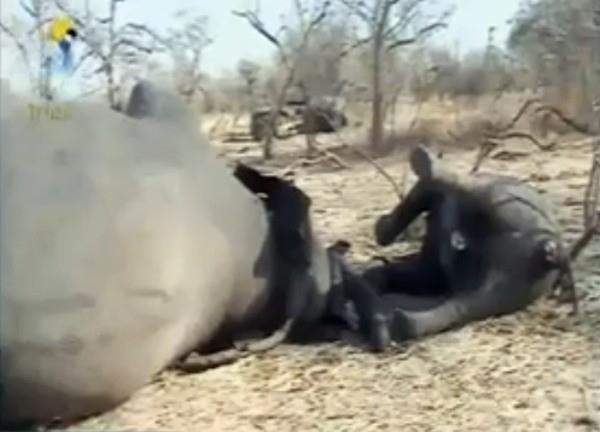
The regime’s indiscriminate violence doesn’t just hit people: this was the terrifying scene that appeared to UN inspectors in March 2013 after irregular troops from N’Djamena killed 86 elephants (including many pregnant mothers) to give ivory to sell to Chinese smugglers[81]
It is no coincidence that in all this story on Lake Chad there is a big absentee: the central government of N’Djamena. A century ago, the country was part of the French colonies and the main ethnic group, the Sara, collaborated with Paris and its boys in both world wars and fought frequently in the French regular army[82]. For obvious reasons, when Chad gained independence, this ethnic group took the reins of the state: the Sara people live throughout Central Africa, are animists and have a tolerant and solid tradition[83]. In the second half of the 20th century, during the years of struggle against the dictatorship of Fidèle Moungar (a son of Lake Chad who was a surgeon in Paris before becoming a politician[84]), Sara stuck to the model of socialist development, which has caused them huge problems with fundamentalist Islam[85].
In 1982, an agreement between the French government and the American oil giant Exxon[86], brought to power the tyrant Hissène Habré[87], one of the bloodiest dictators of the second post-war period, so that the same forces that brought him to power unite their forces, years later, to have him chained and convicted for the massacre of more than 40,000 political opponents[88].
In this latest coup, the French and the Americans relied on one of the many militias already active in the territory, that of the Zaghawa ethnic minority – which took up arms because the dictator Habré loved the massacres of members of the Sara and the Hadjerai tribe[89]. The Zaghawa (only 2.4% of the population of Chad[90]) are Berber shepherds from the Darfur region of South Sudan who have moved in search of better pastures or over the centuries for fear of war and famine[91].
The new dictator, Idriss Déby, has been in power for exactly 30 years and is anything but a cheerful and smiling patriarch. For years his power, legitimized by Paris and Washington, has been defended with the active military support of his mentor, the Libyan dictator Muhammar Gaddafi[92], also because his entire term has been strewn with assassinations and coups[93].
Déby reigns not only because of violence, but also because of the spread of corruption (in which Déby and his government are the protagonists)[94], largely generated by the exploitation of the oil fields of northern Chad and the royalties for the use of more than 1000 km-long pipeline[95] that connects central Chad to port cities in southern Cameroon[96]. The fact is that the Déby regime does not care about the ecosystem of Lake Chad, also because its tribes live in the north and east of the country: it prefers to officially entrust the management of the development and security of the area. to neighboring countries and delegate the action of the United Nations, FAO and UNESCO[97].
We don’t know whether it’s good or bad. Without prejudice to the fact that the government of Cameroon is the most active and the most useful in the fight for the survival of the lake, of its multi-ethnic society and of its ecosystem, as long as there is a selfish and dictatorial regime like that of Déby in N’Djamena, it’s impossible to believe that anyone will do anything for Africa’s largest fish lake.
Western engagement, often self-interested, doesn’t help enough: without FAO and other organizations, the lake might have disappeared and the people around it would have been wiped out by war, disease and famine. Nothing new under the sun: Africa, which with its enormous arms surrounds a seemingly endless colony of cursed places where injustice is paramount, risks being destined for a long time to bear the children of a lesser God.
[1] https://eros.usgs.gov/westafrica/ecoregions-and-topography/ecoregions-and-topography-chad
[2] https://www.limesonline.com/cartaceo/i-confini-mobili-del-lago-ciad?prv=true
[3] Churchill Okonkwo, Belay Demoz., “Identifying anthropogenic ‘hotspots’ and management of water resources in Lake Chad Basin using GIS”, in “Journal of Natural Resources Policy Research”, volume 6, Taylor & Francis, London 2014, pages 135–149.
[4] https://link.springer.com/article/10.1007/BF01956304
[5] About the Igbos: John Eberegbulam Njoku, “The Igbos of Nigeria: Ancient Rites, Changes, and Survival”, Lewiston / E. Mellen Press, New York 1990
[6] https://www.britannica.com/topic/Igbo
[7] Frank A. Salamone, “The Hausa of Nigeria”, University Press of America, Lanham (Maryland) 2010
[8] https://books.openedition.org/irdeditions/11685?lang=it
[9] Felix Watang Zieba, Genesis Tambang Yengoh, Abdouraman Tom, “Seasonal Migration and Settlement around Lake Chad: Strategies for Control of Resources in an Increasingly Drying Lake”, MDPI Verlag, Basel 2017 – see also https://www.mdpi.com/2079-9276/6/3/41/htm
[10] https://www.humanitarianresponse.info/sites/www.humanitarianresponse.info/files/assessments/rapport_de_letude_sur_les_conflits_et_mecanismes_de_resolution_des_conflits_a_lextreme-nord_du_cameroun_final.pdf, pages 22-29
[11] http://www.fao.org/emergencies/crisis/lakechadbasin/en/ ; https://www.crisisgroup.org/africa/central-africa/chad/246-fighting-boko-haram-chad-beyond-military-measures
[12] https://www.mdpi.com/2079-9276/6/3/41/pdf
[13] http://www.fondazionepopoli.org/?cat=60
[14] Adrian Room, “African place names”, Macfarland & Company, Jefferson (North Carolina) 1994; Gerald J. Rizzo, “The Patterns and Meaning of a Great Lake in West Africa”, in “Imago Mundi”, volume 58, Taylor & Francis, London 2006, pages 80-89 – see also https://www.jstor.org/stable/40234021?seq=1
[15] Carlos Magnavita, Zakinet Dangbet, Tchago Bouimon, “The Lake Chad region as a crossroads: an archaeological and oral historical research project on early Kanem-Borno and its intra-African connections”, in “Afrique: archéologie, arts”, volume 15, CNRD Edition, Paris 2019, pages 97-110
[16] https://www.newyorker.com/magazine/2017/12/04/lake-chad-the-worlds-most-complex-humanitarian-disaster
[17] https://www.clingendael.org/pub/2018/multilateral-damage/4-chad-a-new-hub-for-migrants-and-smugglers/
[18] https://www.unodc.org/documents/toc/Reports/TOCTAWestAfrica/West_Africa_TOC_MIGRANTS.pdf ; https://www.bbc.com/news/world-africa-17481181
[19] https://issafrica.org/iss-today/chads-illegal-drug-trade-contributes-to-regional-insecurity
[20] https://www.cairn-int.info/article-E_AFCO_255_0093–boko-haram-and-lake-chad.htm#
[21] https://core.ac.uk/download/pdf/207041595.pdf Par. V pag. 10
[22] https://www.un.org/africarenewal/news/un-migration-agency-chad-appeals-funding-assist-stranded-migrants
[23] http://library.fes.de/pdf-files/iez/05423.pdf
[24] https://www.unfpa.org/data/emergencies/chad-humanitarian-emergency
[25] https://www.bbc.com/pidgin/tori-48611626 ; https://www.reuters.com/article/us-cameroon-security-idUSKCN1TD289
[26] https://actucameroun.com/2019/06/14/le-gouvernement-devoile-lidentite-des-16-soldats-tues-par-boko-haram-a-darak/ ; https://www.lefigaro.fr/flash-actu/cameroun-deuil-national-vendredi-pour-17-soldats-tues-par-boko-haram-20190618 ; https://www.parismatch.com/Actu/International/Le-Cameroun-pleure-37-morts-apres-une-des-attaques-les-plus-meurtrieres-de-Boko-Haram-1630224 ; https://www.jeuneafrique.com/787478/politique/cameroun-au-moins-26-morts-apres-une-attaque-de-boko-haram-selon-un-nouveau-bilan/ ; https://www.lefigaro.fr/flash-actu/nigeria-plusieurs-soldats-tues-dans-une-attaque-de-boko-haram-contre-leur-base-20190614 ; https://www.liberation.fr/direct/element/attaque-boko-haram-au-cameroun-dimanche-18-morts-selon-une-force-regionale_98898/ ; https://www.voaafrique.com/a/trente-sept-morts-apr%C3%A8s-une-des-attaques-les-plus-meurtri%C3%A8res-de-boko-haram/4955899.html
[27] https://www.pndp.org/documents/PCD_DARAK.pdf, pages 157-158
[28] https://www.pndp.org/documents/PCD_DARAK.pdf, pages 153-163
[29] https://www.worldwildlife.org/ecoregions/at0904 ; https://wwf.panda.org/?187941/Decade-old-dream-comes-true-for-Lake-Chad ; https://en.unesco.org/news/unesco-commits-safeguarding-lake-chad
[30] https://www.gov.za/documents/constitution-republic-south-africa-1996, Chapter XII
[31] https://www.constituteproject.org/constitution/Cameroon_2008.pdf?lang=en
[32] https://www.humanitarianresponse.info/sites/www.humanitarianresponse.info/files/assessments/rapport_de_letude_sur_les_conflits_et_mecanismes_de_resolution_des_conflits_a_lextreme-nord_du_cameroun_final.pdf, pages 33-46
[33] https://scholarcommons.usf.edu/cgi/viewcontent.cgi?article=1707&context=jss
[34] https://africasacountry.com/2020/07/the-state-of-lake-chad ; https://en.unesco.org/news/unesco-launches-biopalt-project-safeguard-lake-chad ; https://www.adaptation-undp.org/projects/regional-project-conservation-and-sustainable-development-lake-chad ; https://www.ispionline.it/it/pubblicazione/multinational-joint-task-force-security-cooperation-lake-chad-basin-25448
[35] https://hausa.leadership.ng/budaddiyar-wasika-zuwa-ga-yan-boko-haram/
[36] http://dbpedia.org/page/Boko_Haram
[37] https://www.britannica.com/topic/Boko-Haram
[38] Jacob Zenn, “Boko Haram’s Conquest for the Caliphate: How Al Qaeda Helped Islamic State Acquire Territory”, in “Studies in Conflict & Terrorism”, volume 43, Taylor & Francis, London 2020, pages 89-122 – see also https://www.tandfonline.com/doi/abs/10.1080/1057610X.2018.1442141 ; https://www.gcsp.ch/global-insights/boko-harams-evolving-relationship-al-qaeda ; https://www.wikileaks.org/plusd/cables/09ABUJA2014_a.html ; https://www.files.ethz.ch/isn/184795/5cf0ebc94fb36d66309681cda24664f9.pdf ; https://web.archive.org/web/20161129233128/%20 ; http:/www.thesundaytimes.co.uk/sto/public/magazine/article1680538.ece
[39] https://www.africanews.com/2015/12/30/9-year-old-nigerian-writes-on-terrorism//
[40] https://www.geopolitica.info/tag/mohammed-yusuf/
[41] https://www.americansecurityproject.org/dont-forget-about-boko-haram-a-2019-update/
[42] https://odihpn.org/magazine/the-evolution-and-impact-of-boko-haram-in-the-lake-chad-basin/ ; https://www.bbc.com/news/av/world-africa-35898319
[43] https://www.statista.com/statistics/271514/global-terrorism-index/
[44] https://www.theguardian.com/world/2015/feb/13/boko-haram-militants-launch-first-attack-inside-chad
[45] https://www.nigrizia.it/notizia/nigeria-decine-di-morti-in-un-attacco-a-gamboru
[46] https://www.nytimes.com/2015/02/14/world/africa/boko-haram-carries-out-first-attack-in-chad.html
[47] https://www.adnkronos.com/fatti/esteri/2015/02/04/truppe-del-ciad-uccidono-oltre-miliziani-boko-haram-nigeria_B6YkamZQhwKPIqmsQdculO.html ; https://www.lastampa.it/esteri/2014/08/31/news/iraq-dopo-due-mesi-rotto-l-assedio-di-amerli-truppe-di-baghdad-nella-citta-dei-turcomanni-1.35628450
[48] https://www.europarl.europa.eu/doceo/document/TA-8-2015-0185_FR.html
[49] https://www.nytimes.com/2015/02/05/world/africa/boko-haram-pushed-from-nigerian-town-by-chad-military.html
[50] https://www.crisisgroup.org/africa/central-africa/chad/246-fighting-boko-haram-chad-beyond-military-measures
[51] https://www.premiumtimesng.com/news/headlines/219153-dislodged-boko-haram-sambisa-forest-nigerian-army.html
[52] https://www.nationalsecurity.gov.au/Listedterroristorganisations/Pages/islamic-state-west-africa-province.aspx
[53] https://issat.dcaf.ch/Learn/Resource-Library/Policy-and-Research-Papers/Facing-the-Challenge-of-the-Islamic-State-in-West-Africa-Province
[54] https://issat.dcaf.ch/Learn/Resource-Library/Policy-and-Research-Papers/Facing-the-Challenge-of-the-Islamic-State-in-West-Africa-Province
[55] https://conflictstudies.gics.live/wp-content/uploads/2019/04/GICS-Survival-And-Expansion-of-the-Islamic-States-West-African-Province-Full.pdf pag. 14
[56] https://www.sunnewsonline.com/fish-business-in-lake-chad-region-ruined-by-boko-haram/
[57] https://africa-eu-partnership.org/sites/default/files/apf_factsheet_-_mnjtf.pdf
[58] https://knowledge4policy.ec.europa.eu/projects-activities/multinational-joint-task-force-mnjtf-against-boko-haram_en
[59] https://www.thisdaylive.com/index.php/2020/11/17/eu-delivers-equipment-to-mnjtf-to-combat-insurgency/
[60] https://www.crisisgroup.org/africa/west-africa/291-what-role-multinational-joint-task-force-fighting-boko-haram ; https://www.dw.com/en/africa-boko-haram/a-54111131
[61] https://factcheck.afp.com/has-lake-chad-shrunk-nigerias-president-claimed
[62] https://www.ukessays.com/essays/history/civil-war-in-chad-history-essay.php
[63] Michael I. Draper, “Shadows. Airlift and Airwar in Biafra and Nigeria, 1967–1970“, Hikoki Publications, London 1999
[64] https://www.worldbank.org/en/country/chad/overview
[65] https://www.newyorker.com/magazine/2017/12/04/lake-chad-the-worlds-most-complex-humanitarian-disaster
[66] http://hdr.undp.org/en/countries/profiles/TCD
[67] http://www.fao.org/africa/news/detail-news/en/c/426466/
[68] http://www.fao.org/documents/card/en/c/727da49d-2d76-422f-94e9-b062a0f5e945/
[69] https://www.worldbank.org/en/news/feature/2019/12/17/food-security-in-chad-the-successful-involvement-of-refugees-and-host-communities-in-horticulture
[70] https://peacekeeping.un.org/en/mission/past/minurcat/
[71] https://www.worldbank.org/en/news/press-release/2015/04/29/imf-world-bank-debt-relief-chad
[72] https://www.worldbank.org/en/news/press-release/2018/09/13/niger-world-bank-approves-80-million-to-support-refugees-and-host-communities
[73] https://www.nsagriculture.com/news/farmers-in-chad-project/
[74] https://www.imf.org/en/About/Factsheets/Sheets/2016/08/01/16/49/Catastrophe-Containment-and-Relief-Trust
[75] https://www.imf.org/en/News/Articles/2020/04/13/pr20151-imf-executive-board-approves-immediate-debt-relief-for-25-countries
[76] https://www.africaeaffari.it/29963/fondi-europei-per-sahel-e-lago-ciad
[77] http://www.fao.org/in-action/radhort/fr/
[78] http://www.fao.org/in-action/african-roots-and-tubers/en/
[79] http://www.fao.org/in-action/action-against-desertification/countries/en/
[80] http://www.fao.org/in-action/aicca/en/
[81] https://earthleagueinternational.org/2013/03/20/elephants-massacre-in-chad/
[82] Samuel Decalo, “Historical Dictionary of Chad”, The Scarecrow Press, Metuchen (Middlesex, UK), 1987, pages 49-54
[83] Mario Joaquin Azevedo, “The roots of violence: A history of War in Chad”, Routledge, London 2005, pages 9-11
[84] https://web.archive.org/web/20051016093653/http://www.politique-africaine.com/numeros/pdf/016030.pdf
[85] Kevin Shillington, “Encyclopedia of African history”, Routledge, London 2013, pages 227-229
[86] https://www.thedailybeast.com/steve-coll-on-exxonmobils-sinister-kingdom-and-private-empire
[87] https://www.hrw.org/report/2016/06/28/enabling-dictator/united-states-and-chads-hissene-habre-1982-1990
[88] https://www.bbc.com/news/world-africa-36411466
[89] https://www.bbc.com/news/world-africa-18927845
[90] Institut national de la statistique, des études économiques et démographiques du Chad, “Deuxième recensement général de la population et de l’habitat (RGPH2, 2009). Analyse thématique des résultats définitifs. État et structures de la population”, République du Tchad, Ministère du plan et de la coopération internationale, Institut national de la statistique, des études économiques et démographiques, N’Djamena 2014
[91] John Donnelly Fage, Oliver Roland, “The Cambridge History of Africa”, Cambridge University Press, Cambridge 1975, pages 262-290, pages 306-308
[92] https://foreignpolicy.com/2011/03/05/harvard-for-tyrants/
[93] https://www.thenewhumanitarian.org/report/58438/chad-coup-attempt-foiled-government-says ; https://allafrica.com/stories/200609210706.html ; https://www.nbcnews.com/id/wbna23031600
[94] 2014.08.04 Transparency International on Chad
[95] http://www.columbia.edu/itc/sipa/martin/chad-cam/overview.html
[96] 2014.08.04 Transparency International on Chad, pages 7-8; http://www.umich.edu/~snre492/Jones/pipe.htm ; https://web.archive.org/web/20060903020140/http://english.aljazeera.net/NR/exeres/859EF8EC-2F2F-42B7-B06C-2C4FF20C2E42.htm
Leave a Reply